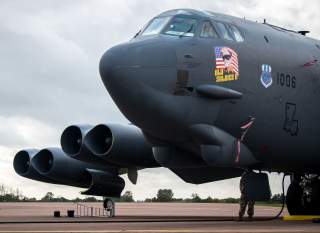100 Years Flying: Meet the Air Force's Plans for the B-52J
An impressive upgrade.
Key point: The Pentagon wants to keep its B-52s operational for the foreseeable future.
The U.S. Air Force could get a new version of the iconic B-52 bomber. The “B-52J” designation might supersede the current “B-52H” moniker that the flying branch has applied to the eight-engine bombers since they entered service in the early 1960s.
Air Force magazine reporter John Tirpak has the story.
“The Air Force is likely to redesignate the B-52H as the B-52J once it receives a slew of modifications adding up to a ‘major modification,’” Tirpak wrote, quoting Brig. Gen. Heath Collins, the Air Force’s program executive officer for fighters and bombers.
The B-52 is slated to receive new engines beginning in about 10 years, and “that probably would be enough” to warrant a letter change, but the venerable bomber will also be getting new digital systems, communications, new weapons and a new radar, as well as a variety of other improvements.
Collins also said that Air Combat Command is considering the possibility of reducing the number of aircrew on the B-52, now that certain functions requiring weapon systems officers can operate autonomously. No decision has been made in that regard, Collins said.
Air Force magazine in its January 2019 issue took a deep dive into the re-engining effort.
"If Air Force plans hold up, the B-52 will be approaching nearly a century of service by 2050," Tirpak wrote in that issue. "To keep the airplane flying, the service plans to equip each B-52 with new engines, which are expected to be so much more maintainer-friendly and efficient that they’ll pay for themselves in just 10 years."
In 2018, the Air Force announced it would retire its 62 1980s-vintage B-1Bs bombers and 20 newer B-2 stealth bombers no later than the 2040s, while the updated B-52Js would continue to operate alongside at least 100 new B-21 stealth bombers.
The Air Force twice in recent years has pulled old B-52Hs from storage in Arizona and refurbished them in order to replace bombers that have crashed. The regeneration efforts have allowed the flying branch to maintain a force of 76 B-52s.
“Despite their age, the B-52s have high mission-capable rates, can carry a huge diversity of weapons, and can perform effectively—as long as the enemy lacks elaborate air defenses,” Tirpak wrote. “Even in a higher-end fight, the B-52 can still launch missiles from well outside enemy air defenses. It is the only U.S. bomber that can launch nuclear cruise missiles, and it will be the initial platform for the new Long-Range Stand-Off missile.”
It took two decades of debate for the B-52 upgrade plan to reach this point. Since 1996 the Air Force has conducted no fewer than 13 studies examining options for new motors for the 240-ton bomber. As of early 2019 the B-52H still flies with the same Pratt & Whitney-made TF-33 engines that have powered the type since 1962.
A 2018 Air Force briefing cited the TF-33's "inefficient and limited capability relative to modern commercially-available engines." The Pratt & Whitney motors are "costly and manpower-intensive to maintain [while] facing obsolescence of parts."
"Modern engines are so much more reliable than the TF-33s that were once installed, the new engines will probably never have to be removed," Tirpak wrote. "The meantime between overhauls for that class of engines is typically around 30,000 hours—greater than the number of hours the service plans to fly the bombers for the rest of their service lives."
The goal in replacing the engines is to improve the B-52's fuel-efficiency by at least 20 percent while maintaining its ceiling and take-off performance. A B-52H with TF-33 engines can carry 35 tons of bombs and missiles as far as 4,500 miles without aerial refueling at a top speed of 650 miles per hour.
"Despite rumors to the contrary, Isabelle said the Air Force is not looking for substantially better physical performance from the new engines—for example, in time-to-climb or top speed—although that may turn out to be a welcome by-product," Tirpak explained.
The Air Force in 2018 estimated the cost of B-52 service-life extension—including the re-engining other capability improvements—at around $32 billion, according to Tirpak.
Between 2011 and 2016 it cost the Air Force around $1.2 billion annually to operate 76 B-52s, the Government Accountability Office reported in 2018.
More efficient engines could save $10 billion in fuel and maintenance costs through the 2040s, Tirpak reported, citing Air Force documents. The service wants 608 engines -- eight for each “new” B-52J.
David Axe serves as Defense Editor of the National Interest. He is the author of the graphic novels War Fix, War Is Boring and Machete Squad. (This first appeared in June 2019.)
Image: DVIDShub.

